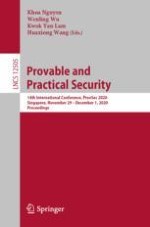This book constitutes the refereed proceedings of the 14th International Conference on Provable Security, ProvSec 2020, held in Singapore, in November 2020. The 20 full papers presented were carefully reviewed and selected from 59 submissions. The papers focus on provable security as an essential tool for analyzing security of modern cryptographic primitives. They are divided in the following topical sections: signature schemes, encryption schemes and NIZKS, secure machine learning and multiparty computation, secret sharing schemes, and security analyses.
* The conference was held virtually due to the COVID-19 pandemic.
